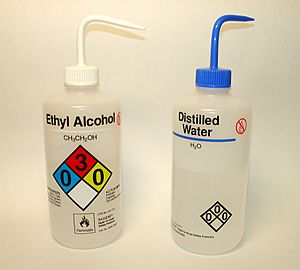Wash bottle facts for kids
A wash bottle is a special squeeze bottle used in science labs. It has a nozzle that lets out a thin stream of liquid. Scientists use them to clean different laboratory glassware, like test tubes and round bottom flasks.
Wash bottles have a screw-top lid that seals them tightly. When you squeeze the bottle, the liquid inside gets pushed out of the nozzle. This creates a narrow stream of liquid, perfect for rinsing.
Most wash bottles are made from a flexible plastic called polyethylene. This plastic is good because it can hold many different liquids used in labs. Many bottles also have a tube inside. This tube lets you use the bottle even when it's standing upright.
Wash bottles can hold many common liquids found in labs. These include pure water (deionized water), cleaning soaps, or rinse liquids like acetone or ethanol. In labs that study living things, wash bottles often hold a special liquid to clean and disinfect old cultures.
Contents
What Are Wash Bottles Used For?
Wash bottles are super handy for cleaning lab tools. They help scientists rinse off chemicals or dirt from glassware. They are also used to add exact amounts of liquid to experiments. For example, you might use one to add water to a beaker or to wash down the sides of a flask.
Colors and Labels on Wash Bottles
Wash bottles often have special colors and labels. These help scientists quickly know what liquid is inside. This is important for safety and to make sure the right liquid is used.
- Red is usually for acetone.
- White can be for ethanol, sodium hypochlorite, or distilled water.
- Green is often for Methanol.
- Yellow is for isopropanol.
- Blue is also used for distilled water.
Safety Tips for Wash Bottles
Safety is very important in a lab! Wash bottles often have warning labels to show if the liquid inside is dangerous.
Some liquids, like ethanol or methanol, create a lot of vapor (gas). For these liquids, wash bottles have small holes in the cap. These holes let out extra vapor pressure. This stops the liquid from squirting out of the nozzle when you don't want it to.
Why Wash Bottles Are Great
Wash bottles help scientists control exactly how much liquid they use. This is very helpful for precise experiments. Also, no unwanted dirt or tiny particles can get into the liquid inside the bottle. Using a wash bottle is often easier than using a beaker or a graduated cylinder for rinsing.
Storing Wash Bottles Safely
Wash bottles are usually kept on the lab bench. They are stored in a way that makes them easy to find. They also need to be stored so they don't get in the way of other work. Sometimes, two special clamps are used to hold them securely on a stand.
Different Kinds of Wash Bottles
There are different types of wash bottles for different jobs.
- A spiral gas-lift wash bottle is good for removing gas from liquids that have two layers, like oil and water.
- A simple graduated wash bottle has marks on the side. These marks help you see how much liquid you have used.
- Nalgene Teflon FEP wash bottles are made from a very strong plastic. These are used for very strong or harmful liquids that might damage other plastics.
Gallery
See also
In Spanish: Piseta para niños





